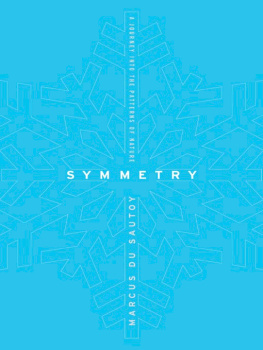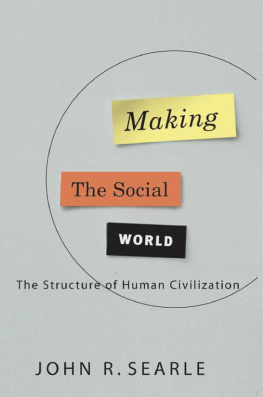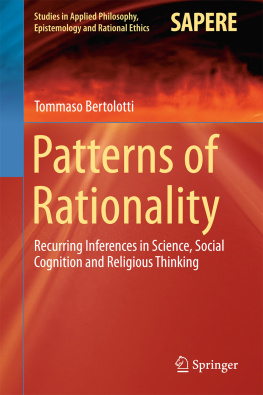John Bolender



vii
xiii
Thoughts about thoughts about thoughts about social relations ...
In this extraordinarily original book, John Bolender outlines not simply a new explanation of the forms of social relations, but an entirely new kind of explanation. Science is the process of looking for patterns, and Bolender describes a fundamental set of patterns-and patterns of patterns-in social life. He explains the fundamental structures of social life-and the systematic relations among them-in terms of their symmetries and the breaking of those symmetries. Electrons are symmetrical to positrons; matter is symmetrical to anti-matter. Symmetries structure crystals and galaxies, the movements of planets and the oscillations of waves, the shapes of flowers and seashells, the anatomy and the locomotion of animals. Bolender draws our attention to the symmetries of social relationships and observes that some relationships are more symmetrical than others. Moreover, the symmetries of some relationships are subsets of the symmetries of other relationships, such that when one of the symmetries of a relationship is broken, the remaining symmetries form another type of relationship. So the symmetries of the four fundamental types of social relationships are ordered in a nested series. In short, Bolender shows that symmetry breaking-a fundamental principle of physics-also structures the universe of social relationships-or, actually, the cognitive models for social relationships and, he plausibly argues, patterns of neural activity that generate the relational models.
When I set out relational models theory (Fiske 1991), I underlined their homology with the four basic types of measurement scales and suggested that their homogeneity and uniqueness under specific transformations also makes them especially well suited to coordinating social relations. I observed that the respective relational models formed a descending, nested series with successively fewer degrees of uniqueness. (For a bibliography of research on relational models, see www.rmt.ucla.edu.) Bolender points out that what measurement theorists call uniqueness under a transformation is what physicists call a symmetry, and that the four fundamental relational models are linked to each other as a chain of descending symmetry subgroups-the property of structures that result from spontaneous symmetry breakdown. Thus he brings sociality into the realm of brain physics.
This chain of symmetries explanation is entirely distinct from theories of sociality based on natural selection, behavioral ecology, genetics, neuroanatomy, neurochemistry, learning or socialization, ontogeny, culture, economy, or communication. In a certain respect, it is a deeply cognitive account, but it takes an entirely novel approach to cognition. Great scientific advances are based on conceiving entirely new approaches to basic phenomena, often by applying perspectives from fields previously thought to be distant to the phenomena at hand. Bolender's approach is entirely new to social science, although it is fundamental to physics and evident in biology as well. Recognizing these nested symmetry subgroups does not deny other sorts of patterns in human life, but provides new insights that in turn raise intriguing new questions. In particular, Bolender's analysis of symmetries and asymmetries in mental representations of social relations forces us to consider whether this explanation contradicts existing theories, and in any case whether it is a better explanation than existing theories. If it complements existing theories, we have to figure out how the theories fit together.
My view is that to fully understand any phenomenon-and certainly to understand social relations-we need to understand how human relationships are shaped by cultures, biology, minds, and physics. I believe that social relations are joint products of all of these processes. What Bolender does is to show that there is a truly fundamental self-organizing physical process underlying social relationships that has hitherto been ignored. And he links this fundamental physics to neuropsychology, hypothesizing that the structures of social relations are produced by a pattern generator in the brain. In any case, Bolender transcends the divide between structural and dynamic explanations: mental representations of social relations are structured by symmetries, which break in determinable order, yielding descending subsets of previous symmetries. This theory thus explains what is simple in social relations and it explains how-and in one sense whymore complex forms of social relations emerge.
In contrast to nearly all previous accounts of social relations, it is not a functional account. Indeed it offers an account of the neurocognitive bases of sociality that in some respects aims to displace, and in other respects complement, adaptationist functionalism. Bolender's discussion of the respective roles of physics and natural selection in the genesis of mental representations of social relations is sophisticated, well informed, and challenging. It will make some functional-adaptive evolutionists squirm (it made me squirm), but it will make everyone think more deeply about what evolution explains, what it doesn't explain, and how the two fit together.
My own view is that natural selection "utilizes" the symmetries and symmetry-breakdowns of physics for their adaptive functions-but only when they are adaptively functional. From this point of view, the symmetries of limbs and gaits are products of natural selection working in a world whose physics determines that efficient but flexible locomotion requires symmetrical support and motion. In water, the physics is different; the most efficient but flexible locomotion there favors a different symmetry, that of a single oscillating tail. In several phyla, natural selection independently converged on oscillating tails for swimming, and in several other phyla converged on symmetrically gaited legs for walking. Some phyla have actually gone back and forth between the two realms: the remote ancestors of mammals swam, but some mammals re-entered the water and re-evolved swimming tails. Cetaceans eventually lost their external limbs. Neither physics alone nor natural selection alone can explain these symmetries, or their history, but the interaction of physics with natural selection does explain them.
What about the structures of social relations? Bolender takes a bold position about the implication of the symmetries of social relations and their chain of symmetry breaking, inferring that these patterns imply that social relations result from physics, not natural selection. I hope that future discussions building on Bolender's analysis will consider whether symmetry and symmetry breaking sequences in the structures of social relations could be constructed from experience, either during one lifetime or cumulatively over many lifetimes in conjunction with cultural transmission or through natural selection. That is, would it be possible for a person, a society, or a species to discover that these four particular structures "worked better" than others? If so, would natural selection, operating though a process of Baldwinian selection, assimilate this experience into the prior expectations built into the organism? Likewise, are these forms of coordination more stable or more efficient than others? Such functional advantages might result from the coherence of their symmetries.











